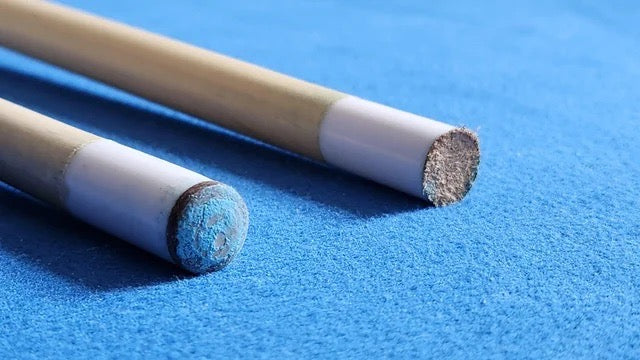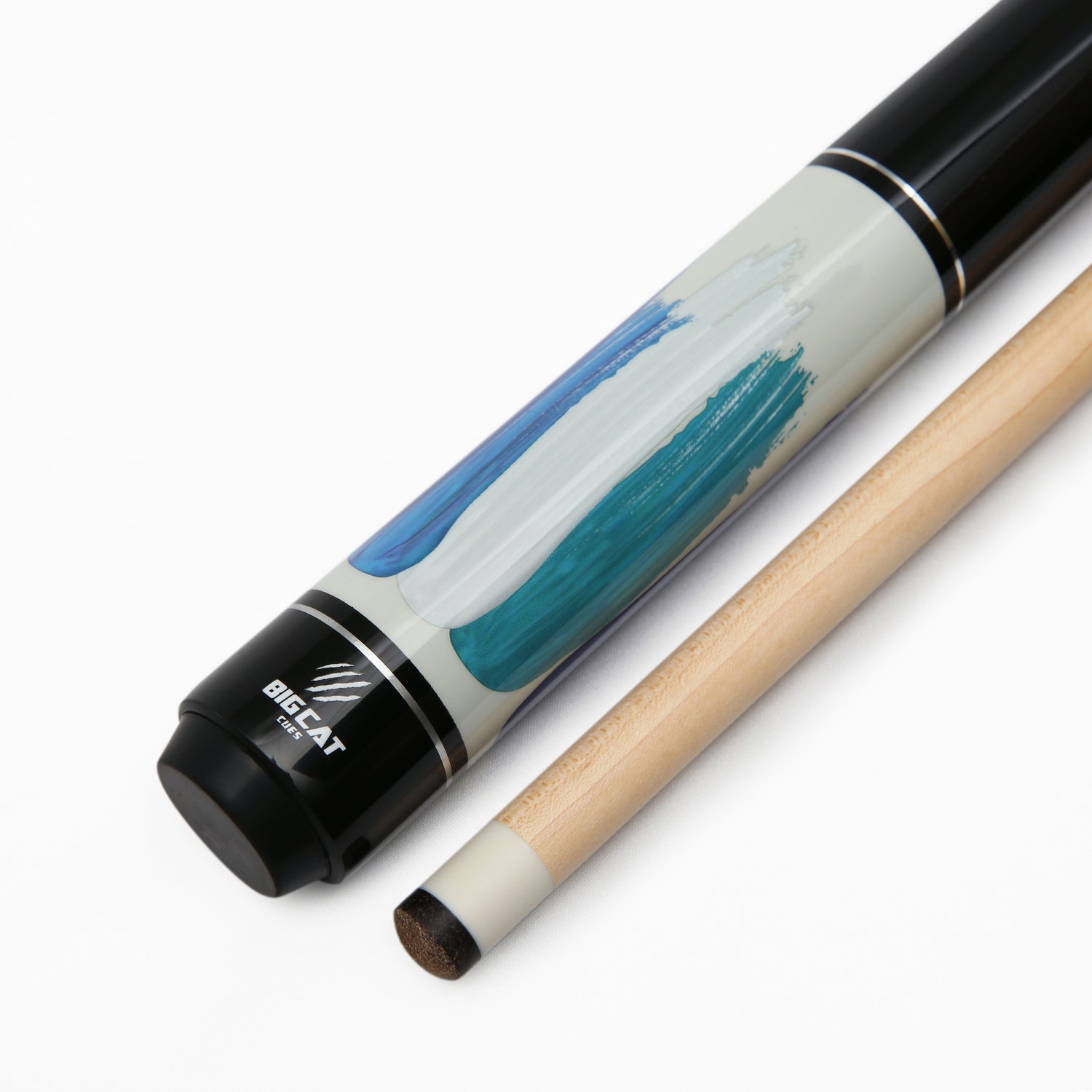
How To Shape A Pool Cue Tip: A Complete Guide
Key Takeaways
- When it comes to how to shape a pool cue tip, remember that the ideal pool cue tip shape is slightly rounded, like a dime or nickel. This shape helps you make better shots and control the ball more precisely.
- The best pool cue tip shaper is a personal choice, but it’s key to get that gentle dome shape just right. Shaping your tip carefully helps it hold chalk better and prevents damage to the tip.
- Regularly checking your tip and adjusting its shape and texture will help you play better. If the tip gets too worn or thin (like a dime), it’s time to replace it for consistent performance.

How To Shape A Pool Cue Tip
Big Cat Cues brings you precision-crafted cues that feel as good as they look. Grab yours and own every shot. Shop us now!
Pool Cue Tip Shape
When figuring out how to shape a pool cue tip, it's helpful to remember that the ideal tip shape is slightly rounded, similar to a dime or a nickel. This pool cue tip shape helps you make accurate shots because it creates a solid and even contact with the cue ball.
- A dime shape (more curved) is great for players who want to put a lot of spin on the cue ball.
- A nickel shape (less curved) gives you a wider contact point, making it easier to control your shots.

Pool cue tip size and shape. Source: Dr. Dave Pool Info
The shape also affects the amount of power and spin you can generate, so maintaining that shape is crucial to consistent play.
Some players like the tighter curve of a dime radius because it gives them more control over spin, so you can really grab the ball and put some serious English on it. Others prefer the broader curve of a nickel radius, as it offers a larger contact area, which can feel more forgiving and provide more power transfer.
The key thing is to pick one and stick with it. Your muscle memory develops around that specific shape, so consistency is crucial.
Read more: How To Replace A Pool Cue Tip? 6 Easy Steps To Install Pool Cue Tips
Hardness and Texture
The feel of your tip is just as important as the shape. Softer tips tend to grip the ball more and let you put more spin on shots, while harder tips give you more solid contact for power shots. Most players find that medium-hardness tips offer a good balance.
You also want your tip to have a slightly rough texture. This roughness helps hold chalk, which is essential for preventing miscues and controlling the cue ball.
How To Shape A Pool Cue Tip
A well-shaped tip provides consistent contact with the cue ball, improved chalk retention, and the control you need for both powerful shots and delicate touch shots.
When your tip gets flattened, mushroomed, or worn unevenly, several problems arise. You'll experience more miscues, lose control over spin, and find it harder to execute precise shots. That's why knowing how to shape a pool cue tip properly is essential for any serious player.
Tools You'll Need
The best pool cue tip shaper is really a matter of personal preference and budget, but here are the main options:
- Tip Shapers and Scuffers: These handheld tools have different abrasive surfaces. Some are shaped like small files, while others resemble small discs with textured surfaces.
- Sandpaper: Fine-grit sandpaper (around 220-400 grit) works well for basic shaping. It's inexpensive and readily available.
- Tip Burnishers: These smooth, hard tools help compress and shape the tip after sanding.
- Chalk: You'll need this to test your work as you go.

You can use a cue tip shaper to make things easier. Source: Amazon
Read more: 8 Best Pool Cue Tips That Are Worth Buying
The Step-by-Step Shaping Process
- Step 1: Assess Your Current Tip
Look at your tip from both straight-on and the side. Is it flattened? Mushroomed over the ferrule edges? Cracked or split? Understanding what you're working with helps determine the amount of work required.
- Step 2: Remove Excess Material
If your tip has mushroomed (spread beyond the ferrule edges), you'll need to trim it back. Use a sharp knife or tip trimmer to carefully remove the excess carefully, working slowly to avoid cutting too much.

Remove excess material from a pool cue tip. Source: PoolDawg.com
- Step 3: Shape the Dome
This is where the magic happens. The ideal pool cue tip shape resembles the curve of a nickel or dime. Start with your shaper or fine sandpaper, holding it at a slight angle to the tip. Rotate the cue while applying light pressure, creating that gentle dome shape.
Work gradually because it's much easier to remove more material than to add it back. Check your progress frequently by looking at the tip from different angles.
- Step 4: Create the Right Texture
Once you have the shape, focus on texture. You want the surface to be slightly rough, not smooth like glass, but not so rough that it tears up your chalk. Use your tip shaper or fine sandpaper in a cross-hatch pattern to create a surface that will hold chalk well.
- Step 5: Test and Refine
Apply chalk and make some practice shots. Pay attention to how the tip feels and performs. If something doesn't feel right, make small adjustments to improve the situation. The highlighy of this process is that you can fine-tune until it's perfect for your playing style.
Taking Care of Your Pool Cue Tip
Your pool cue tip is the most crucial part of your stick since it's what actually makes contact with the ball. Getting the pool cue tip shape right and keeping it well-maintained can make a huge difference in your game.
1. Getting the Right Shape
When it comes to how to shape a pool cue tip, you'll aim for a slightly rounded, convex shape. Think of it like a gentle dome, rather than being completely flat or extremely pointy. This curved shape provides better control and enhances accuracy. However, always check what your cue manufacturer recommends, since different cues might have specific requirements.
If you're wondering about the best pool cue tip shaper, you have a few options. You can use a specialized tip shaper tool, or even fine sandpaper in a pinch, though be gentle with it. The key is maintaining that subtle curve without overdoing it.

Maintaining a pool cue tip is important. Source: Snooker Crazy
2. When Your Tip Needs Attention
Here's something that might surprise you - your tip actually plays better when it's slightly worn! The rougher texture grips chalk much better than a brand-new, smooth tip. So don't rush to replace it just because it's not perfectly pristine.
Keep an eye on moisture, though. Some tip materials handle humidity better than others. Leather tips, for instance, shouldn't absorb too much moisture. If your tip starts warping from getting too wet or if it becomes as thin as a dime, then it's time for a replacement.
Read more: Pool Cue Tip Hardness Chart: A Comprehensive Buying Guide
3. Proper Chalk Application
Part of tip maintenance is knowing how to apply chalk correctly. Don't grind the chalk into your tip, that's too aggressive.
Instead, gently rub it on, focusing on using the middle part of the chalk block. Less is definitely more here, as too much chalk just creates a mess you'll have to clean up later.


